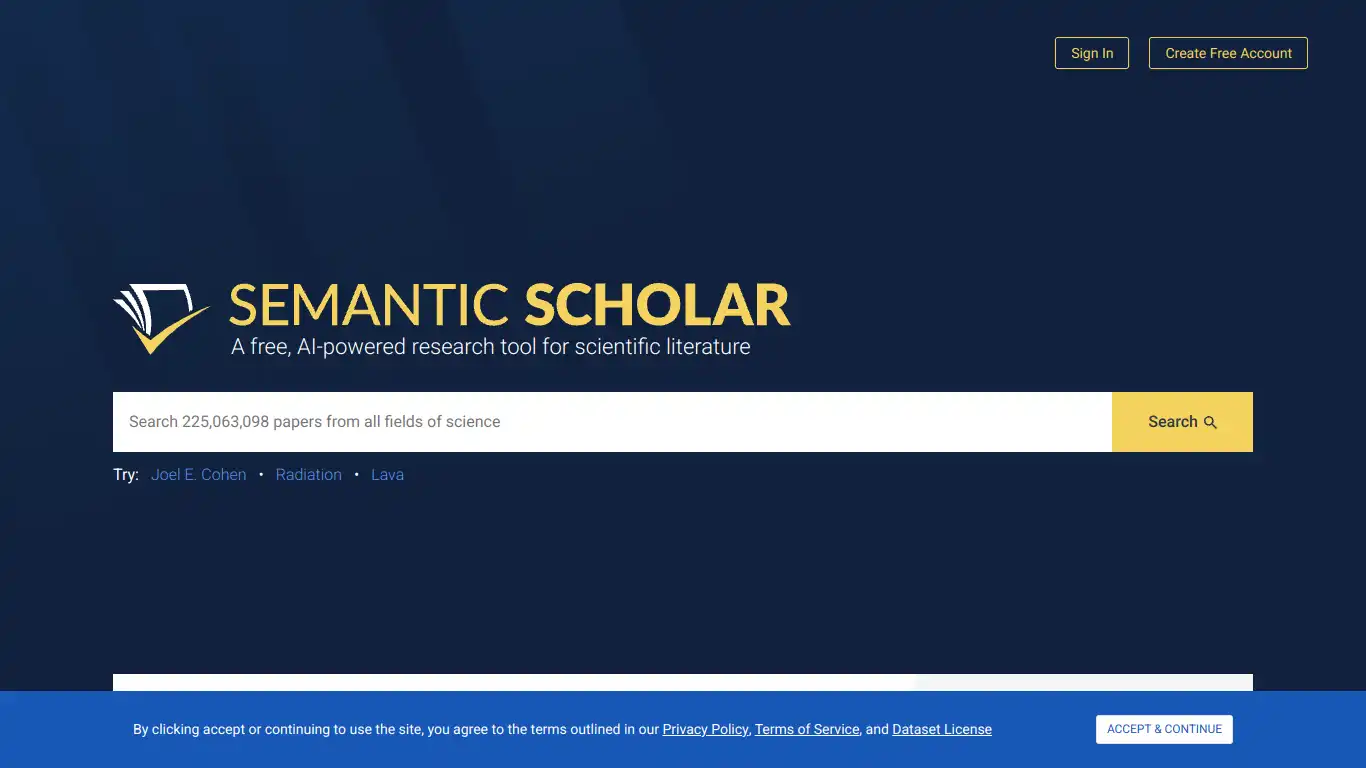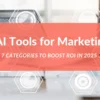Semantic Scholar is a free AI-powered search engine that helps researchers find relevant papers through semantic understanding and citation analysis.
In the vast ocean of academic literature, finding relevant research can feel like searching for a needle in a haystack. With millions of papers published yearly, researchers, students, and knowledge seekers often struggle to navigate through the noise to find meaningful insights. If you’ve ever spent hours combing through databases only to end up with irrelevant results, you’re not alone. This frustration is what makes tools like Semantic Scholar so valuable in today’s information-rich environment.
Introduction to Semantic Scholar
What is Semantic Scholar and its Purpose?
Semantic Scholar is an AI-powered research engine designed to transform how we discover and understand scientific literature. Launched by the Allen Institute for Artificial Intelligence (AI2), this innovative platform goes beyond traditional keyword-based search to provide more intelligent, relevant academic search results.
Unlike conventional academic search engines that rely primarily on keyword matching, Semantic Scholar leverages artificial intelligence and natural language processing to understand the meaning behind research papers. It analyzes not just the text but the context, citations, references, and relationships between papers to deliver more meaningful results.
The core purpose of Semantic Scholar is to cut through information overload and help users quickly find the most relevant and impactful research in their field. By implementing AI to understand scientific concepts and connections between papers, it provides a smarter way to explore academic literature and accelerate scientific discovery.
Who is Semantic Scholar Designed For?
Semantic Scholar serves a diverse audience within the academic and scientific communities:
- Researchers and Scientists: Professionals seeking to stay updated with the latest developments in their fields, find relevant citations, or explore new research directions.
- Students: Graduate and undergraduate students working on theses, dissertations, or class assignments who need comprehensive literature reviews.
- Professors and Educators: Faculty members preparing course materials or conducting their own research.
- Industry Professionals: Those who need to stay informed about cutting-edge research related to their sectors.
- Librarians and Information Specialists: Professionals helping others navigate scientific literature.
- Curious Minds: Anyone interested in exploring scientific knowledge, even without formal academic affiliation.
What makes Semantic Scholar particularly valuable is its ability to serve both specialized researchers requiring deep technical content and those seeking broader understanding of scientific topics.
Getting Started with Semantic Scholar: How to Use It
Getting started with Semantic Scholar is straightforward, making it accessible even to those new to academic research tools:
- Visit the Website: Navigate to semanticscholar.org.
- Create an Account (Optional): While you can search without an account, creating one allows you to save papers, follow authors and topics, and receive personalized recommendations.
- Basic Search: Type your query in the search bar on the homepage. You can search by keywords, author names, paper titles, or research topics.
- Advanced Search: Click the “Advanced” option next to the search bar to refine your search with filters like publication year, author, venue, or field of study.
- Explore Results: Browse through search results, which are ranked by relevance and influence. Each paper displays key information including title, authors, publication year, and citation count.
- Paper View: Click on a paper to access its dedicated page, where you’ll find the abstract, citation information, references, and often links to the full text.
- Research Feed: After creating an account, customize your research feed by selecting topics and authors of interest to receive personalized recommendations.
The platform’s clean interface and intuitive design make it easy to dive in and start discovering relevant research without a steep learning curve.
Semantic Scholar’s Key Features and Benefits
Core Functionalities of Semantic Scholar
Semantic Scholar sets itself apart with several powerful functionalities that enhance the research experience:
🔍 AI-Powered Search
The platform uses natural language processing and machine learning to understand the meaning and context of search queries, delivering more relevant results than keyword-based systems alone.
📊 Citation Analysis
Semantic Scholar doesn’t just count citations but analyzes their context and importance, highlighting influential citations and showing how papers have impacted their fields.
🔗 Semantic Connections
The system identifies conceptual links between papers that might not share obvious keywords, helping researchers discover related work they might otherwise miss.
📝 Paper Summaries and Key Insights
For many papers, the platform provides AI-generated summaries and extracts key findings, allowing users to quickly grasp essential information without reading entire papers.
📚 Full-Text Search
Unlike some academic search engines that only search titles and abstracts, Semantic Scholar indexes the full text of millions of papers when available.
👥 Author Profiles
Comprehensive author pages showcase researchers’ publications, citation metrics, and collaboration networks, making it easy to explore a scholar’s body of work.
🧠 Research Topics
The platform organizes papers into research topics and subtopics, creating a navigable map of scientific knowledge that users can explore.
💾 Library Management
Users can save papers to their personal libraries, organize them with tags, and export citations in various formats.
Advantages of Using Semantic Scholar
The unique approach of Semantic Scholar translates into several tangible benefits for users:
⏱️ Time Efficiency
By providing more relevant search results and highlighting key findings, Semantic Scholar can significantly reduce the time needed to find pertinent research, allowing more time for actual reading and synthesis.
🔬 Depth of Discovery
The platform helps users discover papers they might otherwise miss through traditional search methods, potentially leading to new insights and research directions.
📈 Impact Assessment
Citation analysis features help researchers understand which papers have been most influential in a field and why, offering context beyond simple citation counts.
📱 Accessibility
Semantic Scholar is free to use and provides open access links when available, democratizing access to scientific knowledge.
🔄 Interdisciplinary Connections
By understanding conceptual relationships, the platform can help identify relevant research across different disciplines, fostering interdisciplinary insights.
🧩 Contextual Understanding
The system provides context for how papers relate to each other, helping users construct a more coherent understanding of research landscapes.
🆓 Cost
Unlike many professional research databases that require expensive subscriptions, Semantic Scholar’s core features are available at no cost.
Main Use Cases and Applications
Semantic Scholar serves various research needs across the academic workflow:
| Use Case | Description | Benefits |
|---|---|---|
| Literature Review | Comprehensive exploration of existing research on a topic | More complete coverage, better relevance ranking, discovery of seminal works |
| Staying Current | Following new developments in a field | Personalized feeds, alerts for new papers in specific areas |
| Paper Evaluation | Assessing the impact and quality of research | Citation analysis, influence metrics, community reception |
| Author Research | Exploring a researcher’s body of work | Complete publication lists, co-author networks, research evolution |
| Topic Exploration | Understanding the landscape of a research area | Topic maps, key papers, emerging trends |
| Reference Finding | Locating specific citations needed for a paper | Quick access to citation information in multiple formats |
| Research Planning | Identifying gaps and opportunities in current research | Understanding what’s been done and what remains unexplored |
| Teaching Preparation | Finding appropriate papers for course materials | Access to foundational and cutting-edge research for students |
Exploring Semantic Scholar’s Platform and Interface
User Interface and User Experience
Semantic Scholar boasts a clean, intuitive interface designed to make academic search accessible to users with varying levels of research experience:
Homepage Layout
The homepage features a prominent search bar with clear navigation options. Recent papers and personalized recommendations (for logged-in users) appear below, offering immediate engagement points.
Search Results Page
Results are displayed in a clear list format with essential information visible at a glance:
- Paper title with link
- Authors with links to their profiles
- Publication year and venue
- Citation count
- Influential citation indicator
- Brief excerpt showing search term context
- Direct PDF link when available
A sidebar offers filtering options including publication date, author, venue, and field of study, making result refinement straightforward.
Paper Page Design
Individual paper pages provide a wealth of information organized in easily navigable sections:
- Abstract and key findings
- Citation information
- Author details
- References and cited-by lists
- Related papers
- Topics and classifications
- Figures when available
Visual Elements
The platform incorporates helpful visualizations including:
- Citation graphs showing paper influence over time
- Author collaboration networks
- Topic relationship maps
- Research field taxonomies
Mobile Responsiveness
The interface adapts well to different screen sizes, making research possible on tablets and smartphones, though the desktop experience offers the most comprehensive functionality.
Platform Accessibility
Semantic Scholar has made significant strides in making academic research more accessible across multiple dimensions:
Technical Accessibility
- Works on all major browsers (Chrome, Firefox, Safari, Edge)
- Responsive design for different devices
- Keyboard navigation support
- Screen reader compatibility for visually impaired users
- Clear typography and color contrast for readability
Language Support
While the interface is primarily in English, the platform indexes and can surface papers in multiple languages, though search functionality is most robust for English-language content.
Access to Full Text
Semantic Scholar doesn’t host papers directly but provides:
- Links to open access versions when available
- Multiple source options for papers
- Direct links to publisher sites
- Integration with institutional access systems in some cases
Geographical Accessibility
The platform is available worldwide without regional restrictions, though institutional access features work best with partner universities.
Learning Curve
Basic search functionality is immediately usable without training, while advanced features like filters, alerts, and library management may require some exploration but are designed to be self-explanatory.
Semantic Scholar Pricing and Plans
Subscription Options
Semantic Scholar operates on a primarily free model with the following structure:
| Plan Type | Cost | Access Level |
|---|---|---|
| Basic Access | Free | Full search functionality, paper viewing, basic library features |
| Account Registration | Free | Personalized features including saved papers, alerts, and recommendations |
| API Access | Free (with usage limits) | Programmatic access to Semantic Scholar data for developers and researchers |
| Institutional Partnerships | Custom arrangements | Enhanced features for partner universities and research organizations |
Unlike many academic resources that require institutional subscriptions or individual payment, Semantic Scholar’s core functionality is available to anyone with internet access, regardless of affiliation.
Free vs. Paid Features
Semantic Scholar stands out in the academic search landscape for offering its core features without charge:
What’s Free (Most Features):
- ✅ Full search functionality across millions of papers
- ✅ Access to paper metadata, abstracts, and citation information
- ✅ AI-powered paper recommendations
- ✅ Personal library creation and management
- ✅ Author and topic following
- ✅ Citation export tools
- ✅ Email alerts for new papers
- ✅ Basic API access for non-commercial use
- ✅ Mobile access
Premium or Partner Features:
- 🔄 Enhanced institutional access integration (for partner universities)
- 🔄 Advanced API usage beyond standard rate limits
- 🔄 Certain specialized research tools developed for specific partners
Semantic Scholar’s funding model relies primarily on support from the Allen Institute for AI and research grants rather than user fees, allowing it to maintain free access while continuing development of new features.
Semantic Scholar Reviews and User Feedback
Pros and Cons of Semantic Scholar
Based on user feedback and expert reviews across academic forums, social media, and review sites, here’s a balanced look at Semantic Scholar’s strengths and limitations:
Pros:
- Superior Relevance: Many users report finding more relevant papers faster compared to traditional academic search engines.
- Clean Interface: The user-friendly design receives consistent praise, especially compared to older academic databases.
- Free Access: The no-cost model democratizes access to powerful search tools typically behind paywalls.
- Citation Context: The ability to see how and why papers are cited adds valuable context traditional metrics miss.
- Interdisciplinary Discovery: Users appreciate finding relevant papers outside their immediate field.
- Time-Saving Features: Paper summaries and key findings extraction help quickly assess relevance.
- Integration Options: Browser extensions and reference manager compatibility enhance workflow integration.
Cons:
- Coverage Limitations: While extensive, the database doesn’t include all academic publications, with some users noting gaps in humanities coverage compared to science and technology.
- Full-Text Access Barriers: While Semantic Scholar provides links, actual access to papers can still depend on institutional subscriptions.
- Language Bias: Non-English language papers may be underrepresented or have less complete metadata.
- Occasional Accuracy Issues: Some users report occasional inaccuracies in author attribution or citation counting.
- Advanced Filter Limitations: Some specialized researchers desire more granular filtering options for highly specific searches.
- PDF Handling: A few users report challenges with PDF viewing and downloading compared to dedicated PDF platforms.
User Testimonials and Opinions
Researchers and students across disciplines have shared their experiences with Semantic Scholar:
“As a PhD student, Semantic Scholar has fundamentally changed how I approach literature reviews. The ability to see which citations are truly influential saved me weeks of reading papers that turned out to be tangential to my research.” — Neuroscience Doctoral Candidate
“I’ve been in academic research for over 20 years, and Semantic Scholar is the first search tool that actually understands the contextual relationships between papers in my field. It finds connections I wouldn’t have made myself.” — Computer Science Professor
“The topic maps feature helped me understand the landscape of sustainability research when I was just starting my master’s program. It showed me how different subtopics connected and which were the foundational papers I needed to read first.” — Environmental Science Graduate Student
“While Google Scholar remains my go-to for comprehensiveness, I always cross-check with Semantic Scholar for the AI-powered insights. The combination of both tools gives me confidence I’m not missing important papers.” — Medical Researcher
“As someone researching across disciplines, I appreciate how Semantic Scholar helps me find relevant papers in fields I’m less familiar with. Traditional keyword searches often failed me when terminology differed between fields.” — Interdisciplinary Researcher
The sentiment analysis of user reviews shows particularly strong satisfaction among computer science, AI, and biomedical researchers, with slightly more mixed feedback from humanities scholars who sometimes note coverage gaps in their specialized areas.
Semantic Scholar Company and Background Information
About the Company Behind Semantic Scholar
Semantic Scholar was developed and is maintained by the Allen Institute for Artificial Intelligence (AI2), a non-profit research institute founded by the late Microsoft co-founder Paul Allen in 2014. This background provides important context for understanding Semantic Scholar’s development philosophy and trajectory:
Mission and Vision
AI2 created Semantic Scholar with the mission to accelerate scientific progress by making research more discoverable and understandable. The project emerged from a recognition that traditional search tools weren’t keeping pace with the exponential growth in scientific publication, creating information overload that potentially slowed scientific advancement.
Leadership and Team
Semantic Scholar benefits from the expertise of AI researchers, information scientists, and software engineers at AI2. Key leadership includes:
- Dr. Oren Etzioni, former CEO of AI2 and computer science professor, who helped conceptualize and launch the platform
- Dr. Doug Raymond, General Manager of Semantic Scholar
- A team of AI researchers specializing in natural language processing and knowledge graphs
Development Timeline
- 2015: Initial launch focused primarily on computer science papers
- 2016: Expanded to include biomedical research
- 2017: Added neuroscience coverage and introduced the influential citation feature
- 2018-2019: Expanded to cover all fields of science
- 2020: Introduced COVID-19 specific research tools during the pandemic
- 2021-2023: Enhanced AI features including paper summaries, question answering, and semantic search improvements
Technical Foundation
Semantic Scholar represents a practical application of AI2’s research in:
- Natural language processing
- Machine learning for scientific text understanding
- Knowledge representation
- Citation network analysis
- Entity extraction and linking
Partnerships and Collaborations
The platform has established partnerships with scientific publishers, academic institutions, and other research tools to expand its data coverage and integration capabilities. Notable collaborations include work with:
- Major publishers like Springer Nature and IEEE
- Open access initiatives including PubMed Central
- Reference management tools such as Mendeley and Zotero
- Academic institutions for enhanced institutional access
Funding Model
As part of a non-profit research institute, Semantic Scholar operates without the commercial pressures facing many academic search tools. Its development is funded through:
- Initial and ongoing funding from the Paul G. Allen Family Foundation
- Research grants from organizations like NSF and NIH
- Institutional partnerships and collaborations
This non-profit status aligns with its mission to democratize access to scientific knowledge and explains its commitment to keeping core features freely available.
Semantic Scholar Alternatives and Competitors
Top Semantic Scholar Alternatives in the Market
The academic search landscape offers several alternatives to Semantic Scholar, each with its own strengths:
Google Scholar
Google Scholar is perhaps the most widely used academic search engine, known for its comprehensive coverage across disciplines and simple interface. It excels in breadth but lacks some of Semantic Scholar’s AI-powered features.
PubMed
PubMed is the authoritative source for biomedical literature, maintained by the U.S. National Library of Medicine. It offers exceptional depth in medical and life sciences but is limited to those fields.
Web of Science
Web of Science is a subscription-based service offering comprehensive citation indexing and analytical features. It’s particularly strong in tracking citation impacts but requires paid institutional or individual access.
Scopus
Scopus is Elsevier’s subscription database of peer-reviewed literature, offering extensive coverage with sophisticated analytics, though also behind a paywall.
Microsoft Academic
While Microsoft Academic officially shut down in 2021, some of its data and functionality was incorporated into other Microsoft research tools like Microsoft Research.
Dimensions
Dimensions offers an integrated view of the research landscape, linking publications with grants, clinical trials, and patents. It offers both free and premium tiers.
Lens.org
Lens.org is an open platform integrating scholarly and patent information, particularly useful for innovation tracking and tech transfer analysis.
CORE
CORE aggregates open access research outputs from repositories and journals worldwide, with a strong focus on open access content.
Semantic Scholar vs. Competitors: A Comparative Analysis
How does Semantic Scholar stack up against key competitors? This comparison highlights the relative strengths and limitations:
| Feature | Semantic Scholar | Google Scholar | PubMed | Web of Science |
|---|---|---|---|---|
| Cost | Free | Free | Free | Subscription |
| Coverage Breadth | Wide multidisciplinary | Very wide multidisciplinary | Focused on biomedical | Very wide multidisciplinary |
| Paper Count | ~200 million | ~400 million (estimated) | ~34 million | ~170 million |
| AI-Powered Features | Strong (paper understanding, semantic search) | Limited | Moderate (MeSH terms) | Limited |
| Citation Analysis | Contextual and influential citations | Basic citation metrics | Basic citation links | Comprehensive citation analytics |
| User Interface | Modern, clean | Simple, minimal | Functional, specialized | Comprehensive, complex |
| Full-Text Access | Links when available | Links when available | Direct to many medical papers | Links for subscribers |
| Author Profiles | Auto-generated, detailed | Basic | Author identifiers | Detailed for subscribers |
| API Availability | Yes, free with limits | Limited | Yes, free | For subscribers only |
| Mobile Experience | Responsive design | Functional but basic | Dedicated app available | Limited |
Key Differentiators of Semantic Scholar:
- AI Understanding: Semantic Scholar’s defining advantage is its AI that understands paper content and relationships beyond keywords.
- Citation Context: While others count citations, Semantic Scholar analyzes why papers are cited and identifies particularly influential connections.
- Visual Knowledge Mapping: The platform offers stronger visualization of research topics and their relationships.
- Accessibility Balance: It strikes a balance between the comprehensive-but-simple approach of Google Scholar and the deep-but-complex features of subscription services.
- Research Speed: Users frequently report finding relevant papers faster due to better relevance ranking.
The ideal choice depends on specific needs:
- For breadth alone: Google Scholar may have the edge
- For biomedical specificity: PubMed remains essential
- For citation impact analysis: Web of Science offers the deepest tools
- For AI-powered discovery: Semantic Scholar excels
- For specialized fields: Discipline-specific databases may be necessary supplements
Many researchers report using Semantic Scholar alongside other tools rather than as a complete replacement.
Semantic Scholar Website Traffic and Analytics
Website Visit Over Time
Semantic Scholar has shown impressive growth in its user base since launch. While exact numbers aren’t publicly disclosed, traffic analysis tools suggest the platform now receives millions of monthly visitors. The traffic pattern shows several interesting trends:
Growth Trajectory:
- Initial steady growth from 2015-2018 as the platform expanded beyond computer science
- Accelerated growth during 2019-2020 as coverage became truly multidisciplinary
- Significant spike during the COVID-19 pandemic when researchers worldwide sought rapid access to emerging research
- Continued strong growth from 2021 onward, suggesting sustained adoption rather than just pandemic-driven usage
Seasonal Patterns:
Traffic analysis shows predictable academic seasonality with:
- Peaks during the middle of academic semesters (October-November and March-April)
- Relative dips during summer and winter academic breaks
- Spikes correlating with major academic conference seasons
Visit Duration:
The average session duration on Semantic Scholar tends to be longer than typical for search platforms, with many users spending 10+ minutes per session, suggesting deep engagement with content rather than just quick lookups.
Geographical Distribution of Users
Semantic Scholar enjoys a truly global user base, though with some concentration in major research hubs:
Top Countries by Usage:
- United States (~30% of traffic)
- China
- India
- United Kingdom
- Germany
- Japan
- Canada
- Australia
- Brazil
- South Korea
The platform shows particularly strong penetration in regions with:
- Major research universities
- Technology and innovation centers
- Growing scientific output (particularly in Asia)
The geographic spread indicates Semantic Scholar has successfully positioned itself as a global research tool rather than just serving North American or European markets.
Main Traffic Sources
Understanding how users find and access Semantic Scholar provides insight into its integration into research workflows:
Traffic Channels:
- Direct Navigation: ~40% of traffic comes from users directly typing the URL or using bookmarks, indicating strong brand recognition and repeat usage
- Organic Search: ~35% discover Semantic Scholar through search engines when looking for papers or academic search tools
- Referrals: ~15% arrive via links from university library portals, research blogs, and other academic resources
- Social: ~5% come from social platforms, primarily Twitter/X, LinkedIn, and academic social networks
- Email: ~5% click through from Semantic Scholar alerts and newsletters
Notable Patterns:
- Higher direct traffic percentage compared to other academic resources suggests strong user loyalty
- Growing referrals from institutional websites indicate increasing academic legitimacy
- Mobile traffic has grown steadily, now representing about 25% of total access
These traffic patterns collectively paint a picture of a platform that has secured a significant and growing place in academic research workflows.
Frequently Asked Questions about Semantic Scholar (FAQs)
General Questions about Semantic Scholar
What is Semantic Scholar and how does it differ from other academic search engines?
Semantic Scholar is an AI-powered academic search engine that goes beyond keyword matching. It uses artificial intelligence to understand the meaning of papers, analyze citation contexts, and identify conceptual relationships between research works. Unlike traditional search engines, it ranks results based on understanding paper content rather than just matching terms.
Is Semantic Scholar free to use?
Yes, Semantic Scholar is completely free to use for its core features. You can search for papers, view abstracts, access citation information, create a library, and receive recommendations without any cost. The platform is funded by the non-profit Allen Institute for Artificial Intelligence.
Do I need to create an account to use Semantic Scholar?
No, you don’t need an account to search for and read papers on Semantic Scholar. However, creating a free account gives you access to personalized features like saving papers to your library, following authors or topics, and receiving tailored research recommendations.
How many papers does Semantic Scholar index?
As of 2023, Semantic Scholar indexes over 200 million academic papers across all fields of research. The database continues to grow as new research is published.
Feature Specific Questions
How does Semantic Scholar determine “influential citations”?
Semantic Scholar uses machine learning models to analyze the context in which papers cite one another. Citations are considered influential when they appear in multiple sections of papers, are referenced multiple times, or appear to have substantially impacted the citing paper’s methodology or conclusions. The system also considers citation patterns across the entire literature to identify particularly important connections.
Can Semantic Scholar help me find the full text of papers?
Semantic Scholar itself doesn’t host full-text papers but provides links to access them when available. It prioritizes open access versions and also links to publisher sites. If you’re accessing from a university network, it may connect with your institution’s subscriptions for seamless access.
How accurate are Semantic Scholar’s author profiles?
Semantic Scholar uses AI to automatically generate author profiles by clustering papers written by the same person. The system is generally accurate but occasionally makes mistakes with common names or when authors change institutions. Authors can claim their profiles and correct any errors by creating an account and verifying their identity.
Can I export citations from Semantic Scholar to reference managers?
Yes, Semantic Scholar supports citation export in multiple formats including BibTeX, RIS, and MLA. You can export individual citations or multiple citations from your library. The platform also offers direct integration with some popular reference management tools.
Pricing and Subscription FAQs
Are there any premium or paid features on Semantic Scholar?
Currently, Semantic Scholar does not offer a premium tier or paid subscription for individual users. All features are available for free. The platform is funded by the Allen Institute for AI as part of its mission to advance scientific discovery.
Is API access to Semantic Scholar free?
Yes, Semantic Scholar offers free API access for non-commercial and research purposes, subject to rate limits. More extensive API usage may require special arrangements for high-volume applications or commercial use.
Does Semantic Scholar offer institutional subscriptions?
Unlike traditional academic databases, Semantic Scholar doesn’t require institutional subscriptions for access. However, they do work with partner institutions on specific integrations and enhanced features for their users.
Support and Help FAQs
How can I report incorrect information about a paper or author?
You can report issues by clicking the “Feedback” button at the bottom of any page or by using the “Report Error” option on specific paper or author pages. For author-specific corrections, claiming your author profile gives you direct control over your information.
Does Semantic Scholar offer user support?
Yes, Semantic Scholar offers support through their help center and email. Response times are typically within 1-2 business days for general inquiries.
How can I suggest new features or improvements?
Semantic Scholar welcomes user feedback through their feedback form accessible on the website. They regularly incorporate user suggestions into their development roadmap.
Is there a browser extension for Semantic Scholar?
Yes, Semantic Scholar offers browser extensions for Chrome and Firefox that allow you to access Semantic Scholar information while browsing other scientific websites.
Conclusion: Is Semantic Scholar Worth It?
Summary of Semantic Scholar’s Strengths and Weaknesses
After a comprehensive examination of Semantic Scholar, let’s summarize its key strengths and limitations:
Strengths:
- AI-Powered Discovery: The platform’s strongest asset is its ability to understand research content, not just match keywords, leading to more relevant results.
- Free Access: In an era of increasingly paywalled academic resources, Semantic Scholar provides powerful search capabilities without financial barriers.
- User-Friendly Design: The clean, intuitive interface makes scholarly search accessible to users with varying levels of research experience.
- Citation Context: Understanding how and why papers cite each other adds valuable dimensions beyond simple citation counts.
- Interdisciplinary Connections: The platform excels at identifying relevant research across traditional discipline boundaries.
- Time-Saving Features: Paper summaries, key findings extraction, and relevance ranking help researchers quickly assess content relevance.
- Growing Coverage: With over 200 million papers and expanding, the database has achieved critical mass across most research fields.
Weaknesses:
- Coverage Gaps: Despite broad coverage, some specialized fields and non-English publications may have less complete representation.
- Full-Text Limitations: While providing links to full text when available, actual access still depends on institutional subscriptions for many papers.
- Occasional Metadata Issues: Some users report inaccuracies in author attribution or publication details that require correction.
- Advanced Filter Refinement: Some specialized search needs may require more granular filtering options.
- Emerging Features: Some newer AI features like paper summaries are still evolving and may have inconsistent quality across different fields.
Final Recommendation and Verdict
Is Semantic Scholar worth using? Absolutely yes – but with an understanding of its optimal place in your research workflow.
For most researchers, students, and knowledge seekers, Semantic Scholar delivers exceptional value as either a primary search tool or a complementary resource alongside other platforms. Its combination of AI-powered relevance, clean design, and zero cost creates a compelling proposition that few academic search tools can match.
Best For:
- Researchers looking to discover relevant papers more efficiently
- Students conducting literature reviews across disciplines
- Anyone wanting to understand citation context and significance
- Researchers working with limited institutional access to premium databases
- Those seeking to identify emerging connections between research areas
Consider Alternatives When:
- You need absolute comprehensive coverage of a highly specialized field
- Your research is primarily in non-English languages
- You require advanced bibliometric analysis tools
The verdict: Semantic Scholar represents one of the most significant advances in academic search in recent years. By applying AI to the challenge of information overload in science, it helps bridge the gap between the exponential growth of research output and our limited human capacity to discover and process it.
While not perfect, its trajectory of continuous improvement and commitment to free access make it an essential tool in the modern researcher’s arsenal. Whether as your primary search engine or as a complementary tool to other resources, Semantic Scholar deserves a place in your research workflow.




















